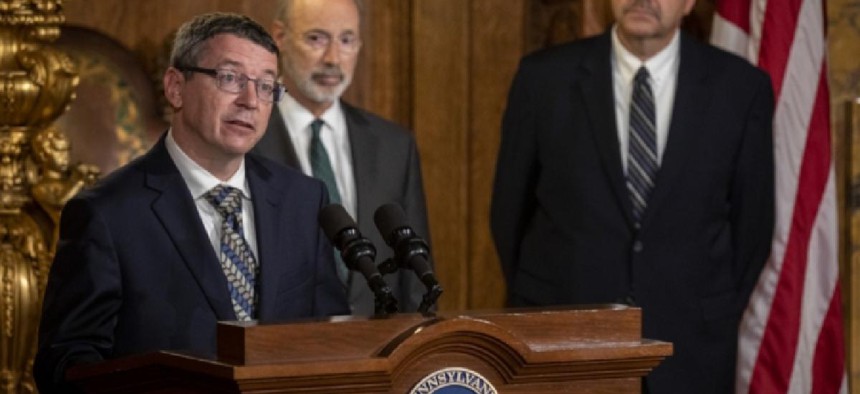Energy
Tom Wolf wants PA to have a carbon-free electric grid by 2050

Pennsylvania DEP Secretary Patrick McDonnell Commonwealth Media Services
Gov. Tom Wolf’s administration on Wednesday unveiled a new plan to fight climate change that calls for the state’s electric grid to be made 100% carbon-free by 2050.
The plan, which includes a total of 18 recommendations to reduce the state’s greenhouse gas emissions, stresses a need to update the state’s Alternative Energy Portfolio Standards Act and require 100% of electricity generated in the state to be from carbon-free sources.
The 2021 Climate Action Plan notes that the shift would result in “both positive and negative economic impacts” in the state and would result in job losses within the fossil fuel industry.
Department of Environmental Protection Secretary Patrick McDonnell noted that, out of all the strategies listed in the plan, decarbonizing the electric grid would result in the most significant reduction in emissions.
“We'll get our biggest greenhouse gas emission reductions from creating a carbon free electricity grid that uses renewable and nuclear energy,” he said during a virtual press conference.
The plan offers suggestions on how to reduce the state’s carbon footprint and lessen the impacts of storms and extreme weather events. It comes as the state continues to grapple with damage caused by the remnants of Hurricane Ida, which battered the southeastern part of the state with flooding and tornadoes earlier this month.
Wolf administration officials outlined the plan on Wednesday and said more actions are needed to lower the state’s greenhouse gas emissions. In 2019, Wolf set statewide goals to reduce Pennsylvania’s greenhouse gas emissions compared to 2005 levels. The administration hopes to lower emission by 26% by 2025 and by 80% by 2050.
The 2021 Climate Action Plan lays out 18 recommendations to hit those goals.
The recommendations include:
- Update and enforce the most current building codes
- Improve residential and commercial energy efficiency
- Increase the use of on-site solar power in the residential and commercial sectors
- Increase vehicle fuel efficiency and reduce miles traveled for single-occupant vehicles
- Increase the use of electric vehicles
- Establish a low carbon fuel standard
- Increase the use of biogas from sources like animal manure and food waste
- Reduce methane emissions from oil and gas systems
- Maintain current nuclear generation levels
- Amend the state’s alternative energy portfolio to create a carbon-free electric grid
- Use programs and incentives to increase energy efficiency in agriculture
- Increase land and forest management for sequestration purposes
The administration’s climate plan also outlines certain hazards that will likely intensify due to climate change, with flooding, rising temperatures and heat waves projected to increase in the coming years.
McDonnell said the state needs to take a two-pronged approach to limiting the impacts of climate change in the Keystone State.
“To be proactive on climate change, we need to do two things,” he said. “We need to significantly lower greenhouse gas emissions to prevent the worst impacts, and adapt to the level of impacts we are already experiencing.”
The administration’s 2021 Climate Action Plan can be read here.
